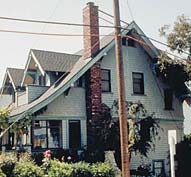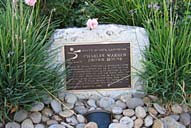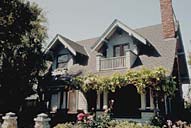




2504 Third St.
Built By: Charles Warren Brown


Charles Warren Brown House, 1908
2504 Third St

detail

Dedication marker in stone

Front view
The Continental Arts & Crafts Movement began in Europe in the second half of the 19th Century. Arts & Crafts is the generic term for this artistic movement. Art Nouveau refers specifically to the French movement. Jugendstil was the name of the German form, Secession in Austria, Style Moderne in Russia, Gaudi in Spain, Glasgow School and Charles Rennie Mackintosh in Scotland.
At the turn of the 20th century, throughout Europe, utopian artist colonies were funded by wealthy "socialists" dedicated to countering the dehumanizing aspects of the machine age. The movement was meant to counter the excess of the Victorian period by returning to the past when handicrafts displayed the laborer's personal involvement in the work.
European writers who embraced the movement were John Ruskin and William
Morris. These writers heavily influenced American designer Gustav Stickley
- one of the leading North American artists involved in the Arts
and Crafts movement.
From 1901-1916, Stickley published Craftsman magazine. It was here that
the terms "California Bungalow" or "California Craftsman"
were first used. As Craftsman magazine flourished the term was broadened,
going beyond Stickley and his work, to encompassing a design style that
spread throughout the country. Craftsman features grew to include street-facing
gables, organic coloring that merged with nature, wide overhanging eaves,
sleeping porches, front doors that open directly into the living room,
dark wood paneling with plastered ceiling (sometimes with wooden beams),
fireplaces, casement windows, arched openings flanked with “built-in”
bookcases which separate living room and dining room, bedrooms with woodwork
painted a light color and kitchen built-ins.
The Craftsman bungalow was California’s contribution to the Arts
and Crafts movement. An important factor in the construction of bungalows
was their ability to meet owners' specific needs. To compliment this new
architectural style, a new concept in interior decorating was introduced
to accommodate this modern approach. Architects such as Gustav Stickley,
Frank Lloyd Wright and the Greene Brothers designed the furnishings, the
hardware, and the draperies that went into their homes. Through style
magazines such as The Craftsman and the Ladies Home Journal, the middle
class was introduced to the Craftsman style. Influenced by the Arts and
Crafts Movement, Craftsman style evolved into an American favorite, embraced
by the country for more than a century.